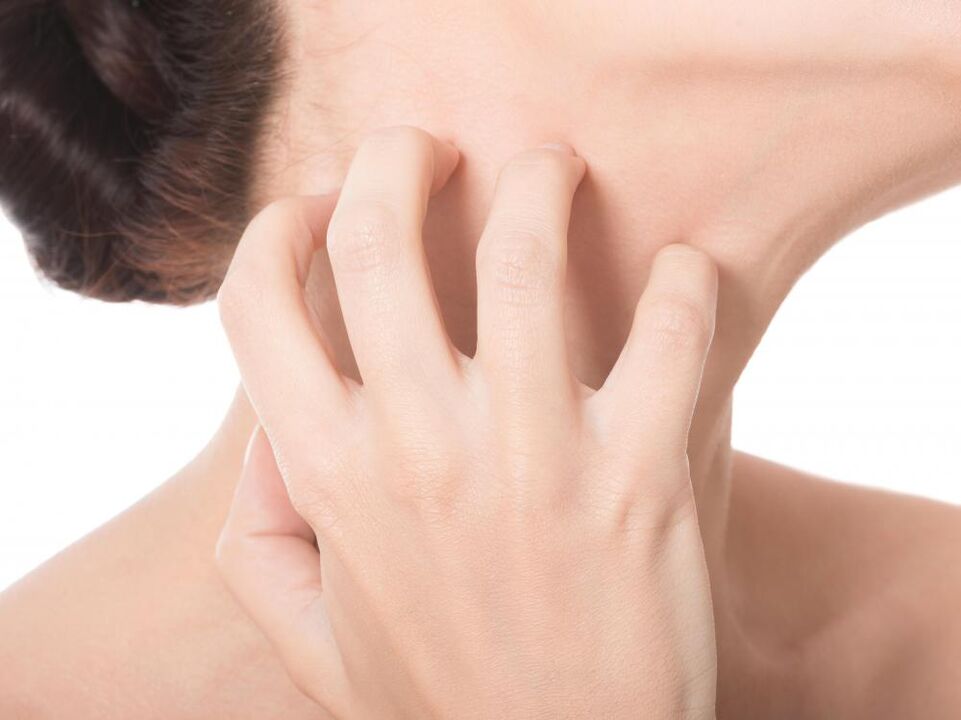
The causes of the skin changes associated with psoriatic plaques are not completely clear. The vast majority of doctors consider genetic predisposition to be a fundamental factor in the development of pathology. Psoriasis is a systemic, non-infectious, chronic, recurring disease that mainly affects the skin, nails and joints.
The main signs and causes of psoriasis
Psoriasis is characterized by increased proliferation of epidermal cells. Normally, cell division, maturation and death occur within 3-4 weeks. In the case of psoriasis, this process takes up to 5 days.
Externally, this manifests itself in the formation of dense areas of red or pink color on the skin, which are covered with small white scales of dead cells. If they are carefully scraped off, a thin, shiny film (terminal) with a clearly visible capillary network is visible. After a slight friction, drops of blood appear on it.
This feature is called the "psoriatic triad" and is the main difference between psoriasis and other skin conditions. To confirm the diagnosis, a histological examination of skin particles from the affected areas is performed.
The main factors that trigger the appearance of psoriasis are:
- Exogenous (external causes). These include various physical or chemical injuries to the skin.
- Endogenous (internal causes). They can occur in the presence of immune and endocrine system diseases, HIV infection. Smoking, alcohol, and an unhealthy diet also cause psoriatic skin changes.
- Psychogenic. In most cases, the first manifestation of psoriasis occurs after a nervous shock or long-term emotional overload.
Skin rashes are often the result of infectious and inflammatory diseases. Many doctors attribute this to a weakened immune system. People with a genetic predisposition to psoriasis are advised to avoid triggers.
Forms of psoriatic diseases
One or another form of the disease depends on the type of rash and its location. Due to changes in the hormonal background during pregnancy, psoriasis manifestations may disappear or, on the contrary, may appear with greater force.
psoriasis vulgaris
The most common form of pathology. The first signs are papular rashes. They can be single, grouped in different parts or all over the body. As the disease progresses, psoriatic plaques grow and gradually merge with each other.
Depending on the form of the rash, normal psoriasis is divided into:
- punctate (papules in the form of matchhead-sized dots);
- teardrop-shaped (elongate spots the size of a pinhead);
- coin-shaped (pea-sized round plaques).
Rashes can be in the form of arcs, circles, spirals, garlands. Sometimes they resemble the outlines of continents on a geographic map. If the disease is localized on the scalp, it is called seborrheic psoriasis. Sometimes the neck, nose, forehead and chest are affected. Due to the similarity of the pathology and seborrhea, the diagnosis is difficult.
Its distinguishing features are the clarity of the boundaries of the affected areas, the presence of the "psoriatic triad", and the silvery color of the scales. There is often itching, the hair does not fall out.
The grouping of plaques on the feet and hands gave the name palmoplantar psoriasis. It is characterized by the formation of polished skin areas reminiscent of corns. Psoriasis of the nails changes their color, shape and structure. They loosen, become covered with small depressions and take the shape of a thimble.
Isolation of discharge from the papules causes a burning sensation. The scales stick together and form a crust that adheres tightly to the skin. In such cases, they speak of the exudative form of psoriasis.
In severe cases, the entire surface of the body is affected. The skin becomes hot to the touch, acquires a red tint, swells, strong itching, burning and tightness occur. This form of the disease is classified as psoriatic erythroderma.
Pustular psoriasis
It happens quite rarely. It develops against a vulgar background or appears on completely healthy skin. In this case, inflamed areas first appear, on which blisters form during the day, which quickly turn into pustules. Their contents are sterile, when drained, they dry out and form a crust.
There are several types of the disease. All of them are characterized by chills, fever, fever, sometimes diarrhea and vomiting. The condition worsens when the pustules coalesce and occupy a large area of skin. If pustular psoriasis occurs against the background of psoriasis vulgaris, fusion is not observed.
Arthropathic psoriasis
It affects the joints, most often the small joints (phalanges of the fingers and toes). Sometimes the pathological process affects the spine. This form of psoriasis often leads to disability.
The first signs of the disease are pain aggravated by movement and swelling of the joints. Evening fever, disturbance of the gastrointestinal tract, loss of appetite are characteristic of the worsening of the disease.
Over time, joints deform and loss of mobility occurs. The pathology can develop independently or simultaneously with the skin manifestations of psoriasis vulgaris.
All forms of pathology can develop gradually, over years, or quickly, over several days or even hours. The treatment regimen depends on the form and extent of the disease and must be compiled by a specialist dermatologist.
Most often, external agents are prescribed in the form of ointments and gels, as well as physiotherapy. In some cases, drug therapy is necessary. Self-medication can lead to worsening of the disease.























